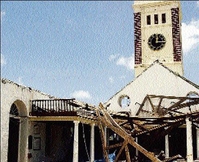Towards a regional risk-mitigation plan
Published: Sunday | May 3, 2009

Young
With climate change exacerbating the Caribbean's exposure to natural disaster risks and the shrinking global economy putting pressure on governments' resources, the region has no doubt grown more vulnerable to disaster shocks, including inflation, food insecurity and joblessness. Our interdependence is evidenced not only by our social, political and economic ties, but also by our geographical proximity.
National catastrophes can easily become regional crises.
Last September, after Haiti was battered by four consecutive storms, its shell-shocked citizens began to leave their homes and head across the border to the Dominican Republic, or board boats to take them to the Turks and Caicos Islands, The Bahamas and the United States. The immigrants brought with them urgent health and social needs, the cost of which would have to be borne, at least temporarily, by host countries.
Early this year, Montserrat's active Soufriere Hills volcano carried ash as far as Antigua, 35 miles northeast of its origin. Five years ago, the same volcano covered hundreds of homes in St Kitts and the Nevis with a blanket of similar ash. Volcanic ash is not the only threat the region faces because of the Soufriere Hills - volcanic debris has the potential to trigger tsunami.
Hurricane Ivan in 2004 directly and significantly impacted multiple Caribbean territories. That single hurricane event wreaked havoc in Grenada, the Cayman Islands and Jamaica. The damage attributable Hurricane Ivan was almost double the annual gross domestic product (GDP) in Grenada and at least equivalent to the GDP of the Cayman Islands.
Regional cooperation
A regional solution is needed for our shared risks. The call for a regional disaster risk-mitigation plan is not a new one. The benefits of regional cooperation have been long championed by Caribbean decision makers, leading to the creation of, among others, the Caribbean Disaster Emergency Response Agency and the Caribbean Catastrophe Risk Insurance Facility.
Still, in light of the extraordinary circumstances presented by a global recession, the interconnectivity of Caribbean economic and social systems, and the negative consequences of global warming, regional governments and businesses must continue to look for and develop regional solutions to limit the Caribbean's natural disaster risk exposure.
Public-private partnerships (PPPs) stand to play a very important role in the development of a coordinated Caribbean response to disaster risk, since the gains to be had from a strong business/government relationship in building regional solutions are many. Regional PPPs help Caribbean governments to develop useful disaster risk-mitigation tools by pooling the human and financial resources of each sector to develop a comprehensive solution, using the valuable input of a wide cross section of Caribbean expertise.
There are other long-term benefits of these partnerships. First, they can be used to initiate technically complex disaster risk solutions, which can then end up being stand-alone entities independent of ex-regional donors and with the sole purpose of serving the needs of the Caribbean people as cost-efficiently as possible.
Second, PPPs can provide systemic training and skills enhancement leading to the development of a cadre of capable and knowledgeable public- and private-sector professionals adequately equipped to deal with complex public-private partnerships transactions. This benefit is an important one to Caribbean governments as they seek to increase the technical capacity of their country's workforce and diversify their service economies.
Public-private partnerships

This Catholic Church on Cooper Hill, St George's, Grenada, was obliterated by Hurricane Ivan in 2004. - Norman Grindley/Deputy Chief Photographer
Third, PPPs offer alternatives to full privatisation or nationalisation combining the advantages of both the public and the private sector and sharing the risk with the development of a solution across the sectors.
Public-private partnerships also have the very significant benefit of lowering the basic risk of a project through the pooling of resources and spreading risks across the region, making risk-management solutions much more cost-effective in the long run. Finally, PPPs have increased in favour with donors and international financing institutions as a developmental facility since, when done properly, they can achieve greater value for money than if the project had been done either by using only public or private sector input.
In recent years, the United Nations has launched the Public-Private Alliance for Rural Development (2003) and the Public-Private Partnership for Urban Environment (2002), while the World Bank has launched its own Public Private Partnerships in Infrastructure project. Developing middle-income nations (as found in the Caribbean) are particularly attractive to these organisations because of our stable political structures and sophisticated financial systems.
All this is not to say that PPPs are solutions that are easy to implement. Public-private partnerships have always been difficult propositions for the groups that wish to create them. Ownership of ideas, consensus and cost sharing are contentious topics, especially when they are broached at a regional level.
This is no different in the Caribbean, where political views coupled with limited resources decide whether a good idea can become a useful one. Still, in light of the opportunities they present, igno-ring PPPs would be far too costly for a region that so clearly needs them.
Dr Simon Young is CEO of Caribbean Risk Managers (CaribRM), a subsidiary of the CGM Gallagher Group, the English-speaking Caribbean's largest insurance intermediary.
